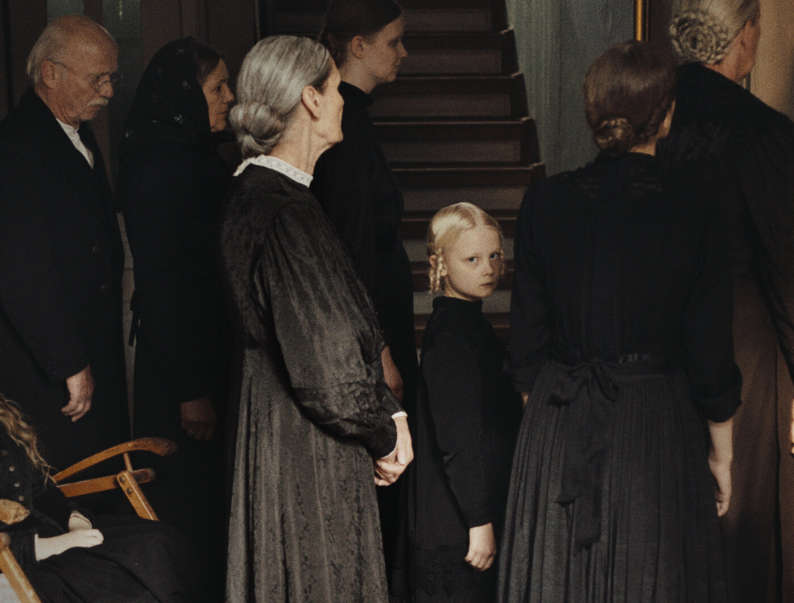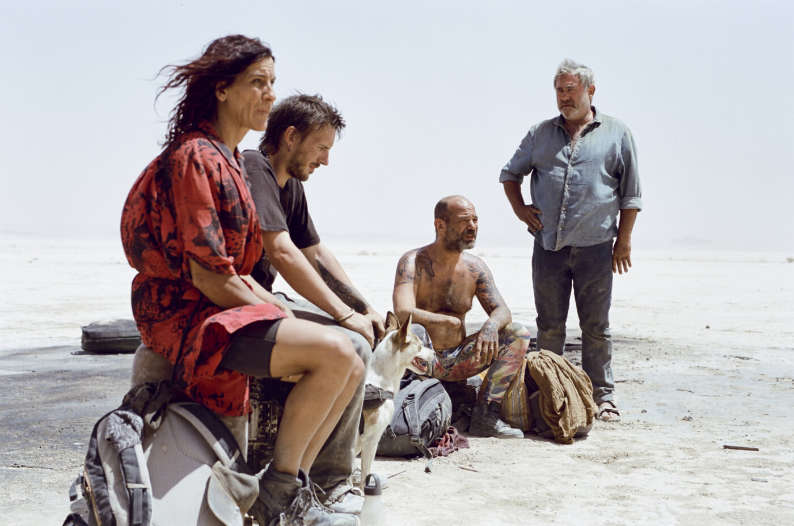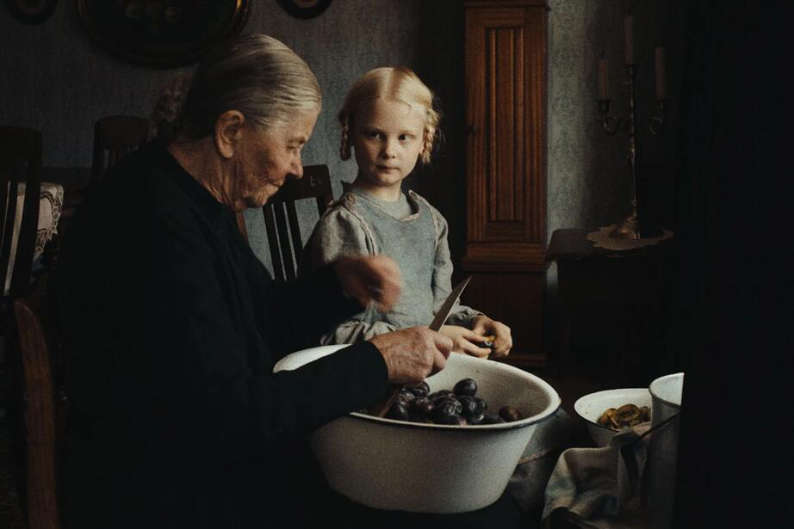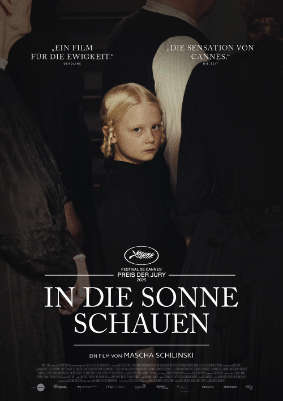Sirât / Sound of Falling
Jerry Whyte reports from the London Film Festival on two hot tickets: Óliver Laxe’s SIRÂT and Mascha Schilinksi’s SOUND OF FALLING – riveting, ravishing films, shot in 16mm and 35mm respectively, that transport audiences, even cinema itself to places they’ve not been before.
Two stand-out films in this year’s London Film Festival programme, Sirât and Sound of Falling, arrived having already shared the honour – conferred by Juliette Binoche, no less – of the prestigious Jury Prize at Cannes. London’s autumnal position in the festival calendar enables its eagle-eyed programmers to cherry-pick glittering gems that dazzled at Berlin, Cannes and Sundance, and to build on buzz from Toronto and Venice. The ‘Big Five’ may lead the way, but late-arriving London, while light on World Premiers, earns its spurs as ‘the best of the rest’, incidentally acting as a winter weathervane for films predicted to sweep the Oscars. Like Sundance, it operates as a snapshot of public opinion rather than a marketplace; the frenzied buying and selling having already been done, earlier and elsewhere, London is free to champion the virtues of open access. Audiences count at the LFF, even if its claim to our hearts as the ‘People’s Festival’ must be qualified by recognition that most people don’t watch most films screened at most festivals.
Would that it was not so, but films as powerful and complex as Sirât and Sound of Falling (coincidentally paired on the same page in the LFF brochure’s DARE section) are unlikely to appear on high streets or in multiplexes. This dispiriting reality points to the vast and growing chasm separating (what remains of) popular cinema from what may be seen at film festivals or in (increasingly expensive) boutique cinemas and read about in the ‘quality’ broadsheets. Here we have the consolidation of a rarified, virulently anti-democratic cinematic ecosystem that excludes most people and amounts to one big bourgeois ghetto.
It is shameful that cinema and our wider culture continue to be diminished and debased by this division on class lines (fast food, popcorn and franchise schlock for the masses: à la cartedining, fine wine and the best cinema has to offer for the few). Popular audiences have certainly been priced out of excellence, but it might also be argued that they have been so conditioned by an infantilised and infantilising culture that they gladly gorge on audiovisual candy floss. Ah, what though of individual agency? At what point does enjoyment of easy entertainment bleed into wilful ignorance? As Ewan McColl asked in The Ballad of Accounting, ‘Did you stand aside and let ’em choose while you took second best?/Did you let ’em skim the cream off and then give to you the rest?/Did you settle for the shoddy and did you think it right/To let ’em rob you right and left and never make a fight, never make a fight, never make a fight?’

Sirât and Sound of Falling are expertly crafted, rewarding, riveting films. They are also comparatively long films, running at 115 and 149 minutes respectively. As such, they test attention spans impaired by accelerated mainstream cinema, rapid-fire TV images, and mobile phone use, among other things. The diminished capacity of contemporary audiences to concentrate is just one of the questions these extraordinary films raise. They revive the contending arguments about experiment and difficulty, modernism and obscurantism, freedom of choice and flattening homogenisation. Those of us who clamour for cultural democratisation and demystification will inevitably be accused of elitism by those who say it is a good thing that our culture provides people with what (they say) they want, not what (they say we say) is good for them. So it goes.
As long as cultural capital remains unequally distributed, apostles of the laws of supply and demand have their own questions to answer. Of course, it would be reactionary to ignore deeply embedded structural inequality and suggest that everyone can as easily benefit from ‘great’ culture or from voluntary immersion in what Mathew Arnold called ‘the best that has been thought and known’. We can, though, defend the idea that some books and films are better than others and that engagement with better works is more rewarding than encounters with dross.
As the LFF got underway and such thoughts crowded in, a happy coincidence occurred: László Krasznahorki was awarded the Nobel Prize for Literature. The visionary Hungarian author is, as readers will know, best known for his bleak but beautiful early novels Sátántango and The Melancholy of Resistance – both of which were adapted Krasznahorki’s peerless compatriot Béla Tarr. These Mittel-European virtuosi are symbols of complexity and difficulty who plough their own furrows over the bones of the dead and stand in opposition to the dominant culture in their willingness to probe the darker corners of the human condition.
Resistance has its own rewards, but Krasznahorki deserves a wider readership and, having won that Nobel Prize, he may now get one. Awards may be absurd, but not as asinine as a culture in which great work must be stamped for approval before being considered fit for public consumption or as imbecilic as those busy amusing themselves to death and content to be led by the nose. I used to tote a Tote bag advertising the Independent Cinema Office. It was graced by the words, ‘Everyone should have access to cinema that nourishes the soul and changes lives’. Which leads me back to Sirât and Sound of Falling and the realisation that such films, daringly original and resistant to the demands of commerce as they are, might be buried beneath vast noise without exposure on the festival circuit and participation, no matter how unwilling, in the awards circus. Sadly, it is difficult to see either film cross over to the mainstream or, indeed, to see their creators wanting to do so.
Sirât
Co-produced by Pedro Almodóvar, Óliver Laxe’s mesmerising fourth feature is the defiantly left-field work of a director so confidently in command of his medium that he is happy to take risks, a lot of risks. Sirât is bold, brave, radical, and charged with political purpose. Laxe consistently disrupts narrative convention with a series of viscerally shocking plot twists and upends social norms by working with a primarily non-professional cast of loveable anarcho-punks.
Laxe himself, cinematographer Mauro Herce (who uses Super 16mm stock to stunning effect), and composer David Lettelier aka Kangding Ray (whose subtly shifting score supplies the film’s beating heart) together build a haunting, ethereal atmosphere out of electronic sound and the desert landscape of the Maghreb. This stark contrast between high-end technology and immutable nature generates a tremulous tension befitting a film that take us beyond imminent apocalypse to the end of the world.
The story Sirât tells is superficially simple: disconsolate Dad Luis (brilliant Spanish actor Sergi López) searches for his missing daughter, Mar, with the help of his adolescent son, Esteban (Brúno Nuñez Arjona), their cute dog (Pipa/Lupita), and an itinerant collective of warm-hearted, weather-beaten, battle-hardened ravers. As the opening credits roll, skilled hands assemble banks of battered amplifiers in front of an inscrutable, eerily watchful sandstone cliff face on the ancient Sahara’s endless edge. A rave bursts into pulsating life. An expertly executed arial shot picks out a moving mass of bodies before the camera descends to track individual dancers, outsiders all, as they shimmy and sway, gyrate and writhe in an ecstasy of self-expression and joy. Luis and Esteban weave through the gathering giving out homemade fliers. They draw a blank, but eventually happen upon a group who suggest that Mar might be at the next rave.

The next morning, Luis, clean out of options and increasingly desperate, instinctively follows the two sturdy trucks carrying techno-nomads Bigui (Richard Bellamy), Jade (Jade Oukid), Josh (Joshua Liam Henderson), Stef (Stefania Gadda), and Tonin (Tonin Janvier). When Armed Forces arrive to announce that World War Three has begun and steer the convoy of ravers away from their last chance to dance, Jade leads a breakout – with Luis taking up the rear in a tiny city runaround entirely unsuited to the terrain. As this unlikely band push ever deeper into the desert and the Atlas Mountains, the perils they face increase, and their existential search for meaning intensifies. It becomes increasingly evident that this is a journey into the heart of darkness and that Sirât is no more a straight-up road movie or Western than John Ford’s The Searchers was.
Driven by the propulsive beats of Hard Techno yet anchored in the ambient rhythms of Trance, earthed in the indifference of an antediluvian landscape yet ever conscious of the rapidly shifting sands of human time, Sirât is simultaneously explosive and meditative, political and metaphysical, tough and tender, dystopian but possessed of a fragile optimism. Although it owes an obvious debt to Clouzot’s The Wages of Fear and George Miller’s Mad Max series, it also recalls the elemental desert beauty of both Antonioni’s Zabriskie Point and David Lean’s Lawrence of Arabia. It also echoes the radical mysticism of Tarkovsky’s Stalker. A more contemporary touchpoint might be Paul Thomas Anderson’s One Battle After Another, which also features a small band of refusenik rebels at odds with a world gone mad and fast disintegrating.
There has never been a shortage of people proclaiming that ‘The End of the World is Nigh’ nor of films claiming the same. Laxe tells us that World War has broken out, but leaves us to imagine the ecological, social and political catastrophes at play beyond the desert. The ravers’ mythical odyssey and Luis’s forlorn search for his daughter stand as a metaphorical defence of stubborn hope in the face of Armageddon. That hope seems dashed in the film’s apocalyptic finale, but another hope lingers: that the power of love and the life force of creative community, as represented by relations among the film’s protagonists, might endure.
The photogenic ravers in the film play themselves, with elegant restraint, so they immediately secure our sympathy and demand our attention. Who, we ask, are these fascinating, funny people? Laxe spent over a decade developing this project, during which time he came to know them, appreciate their music, make common cause with their life-affirming rebellion, and earn their trust. It may be regrettable that we learn nothing of their backstories but, given Bigui’s truncated forearm and Tonin’s missing leg, we can also assume they’ve lived the life.
Experience may have taught them to keep themselves to themselves, but the virtues of self-reliance and solidarity – born, surely, of adversity and resistance – bind their nuclear (and-pre-nuclear) found family. Although they are initially reluctant to let Luis and Esteban tag along, the obligations of mutual aid and shared humanity finally prevail, and the family is extended. Wary habit and precautionary suspicion gives way to mutual affection and respect. A new community is born. Hope dies last.

The love that clearly exists among the close-knit ravers is as moving to behold as the tender bonds that gradually form between them and Luis and Esteban. They are all in it together, and whatever it is, it ain’t gonna be pretty. ‘Is this is what the end of the world feels like?”, asks Bigui. ‘It’s been the end of the world for a long time’ replies Tonin. Finally, it is not love that tears them apart but technology, the hardware of human ingenuity. That which facilitates our pleasure and travel, Laxe seems to say, may ultimately prove our downfall.
In José Saramago’s great allegorical novel Blindness, society reverts to barbarism when an epidemic of, yes, blindness rips through it. One woman alone, a doctor’s wife, miraculously retains her sight. She feigns blindness to remain with her husband when the afflicted are quarantined. ‘If we cannot live entirely like human beings, at least let us do everything in our power not to live entirely like animals, words she repeated so often that the rest of the ward ended up transforming her advice into a maxim, a dictum, into a doctrine, a rule of life, words which deep down were so simple and elementary’. It is an idea that seems to shape Sirât.
Profoundly thought-provoking and punctuated by moments of gut-wrenching horror though it is, Sirât is also extremely beautiful. Indelible images of truck headlights slicing through desert darkness and tracing slashes across Atlas Mountain passes burn themselves on our eyes. Thunderous noise alternates with ineffable silence to leave our ears ringing. This is the kind of visual and sonic sensory experience cinemas were built for. Please, please do NOT insult cinema, Laxe and his team by watching Sirât online. Queue overnight, if you must, for tickets to see this extraordinary film in a cinema. If you’re otherwise engaged or elsewhere, you have our sympathy, track it down at as soon as you can.
Sound of Falling [In die Sonne schauen]
Cinema has gifted us many kaleidoscopic epics charting the lives of communities and families. That Mascha Shilinski’s astonishingly assured and audacious second feature, Sound of Falling, can hold its own alongside such imperishable classics as Bergman’s Fanny and Alexander, Terence Davies’s Distant Voices, Still Lives and Edgar Reitz’s Heimat is one thing. That it manages to draw and build upon them while remaining utterly unique is another feat entirely. Such chronicles have traditionally focused on violent patriarchs; here, Shilinski foregrounds the experience of women and girls – their oft-elided sexual desires and shameful secrets, their necessarily small triumphs against stacked odds, above all, their silent screams of unspoken suffering.

Shilinski’s debut, Dark Blue Girl, grew from a third-year Hamburg film school project. It was a modest, if psychologically astute low-budget coming-of-age drama that offered few hints at the heights to which its director would rise. From small acorns, mighty oak trees grow. While developing Sound of Falling, Shilinski and her co-writer Louise Peter rented an abandoned farmstead in the rural Altmark region of Saxony-Anhald. As they wrote, amid the creaks and groans of a rickety building that had long lain dormant, they began to wonder what might once have happened there. This seepage of the past into the present intensified when, during their research into the region’s largely undocumented past, they found a 1920 photograph of three maids or agricultural workers staring straight at the camera. Who, they wondered, were these women frozen in time, and what kind of lives had they lived? As if by osmosis, their subject had announced itself and Schilinski had found her location.
Sound of Falling, though earthed in one place, flows fluidly back and forth through time to create an impressionistic, novelistic, lyrical portrait of rural Germany and four generations of women living in the same farmhouse down approximately a century. Death hangs heavy in the interwoven vignettes that reveal the fragility of life (a bacchanalian All Souls Day party and assorted group photos honour the dead), but, by granting prominence to the child’s eye perspective she deployed in Dark Blue Girl, Shilinski simultaneously celebrates life’s mystery and majesty.The film owes much of its extraordinary cumulative power to this accumulation of intertwined pointillist fragments. It is difficult to join the dots at a first viewing, but Shilinski allows for a chronology, of sorts, by tracking the lives of four girls: successively, flaxen-haired Alma (Hanna Heckt) prior to the outbreak of the Great War, Erika (Lea Drinda) after the Second World War, Erika’s fearless niece Angelika (Lena Urzendowsky) toward the collapse of the calcified GDR and, finally, Lenka (Laeni Geiseler) after reunification in an approximate present. History sweeps the girls through to womanhood as it will sweep us all away and as the River Elbe sweeps away the primordial eels that squirm in its waters.
Sound of Falling rings with jollity and joy one moment and harrows with pitch black horrors the next. As the film begins, Alma and her sisters play a delicious practical joke on a housemaid by nailing her clogs to the floor. The maid returns, falls flat on her face, plays dead, rises, then chases the giggling, shrieking girls around the house. Later, we see the community playing a traditional game in the farmstead courtyard. One after another they circle the yard on bicycles before grabbing or failing to grab eels from a bucket. Such episodes emphasise the easy camaraderie and humour that alleviate a hard and often brutal agrarian life.

As the film unfolds, the mood darkens as illicit, iniquitous longings surface – with incidences of incestuous rape, suicide (one scene echoes Rossellini’s Germany Year Zero), female mutilation (the maids are sterilised to ‘protect’ the men), and even, effectively, familial mutilation: Alma’s brother, Fritz (Filip Schnack), suffers ‘a work accident’ brought on by his parents, as conscription beckons. As a teenager, Erika develops an erotic fascination with her Uncle Fritz (Martin Rother) and his amputated leg. His sexual needs are subsequently attended to by a maid, Trudi (Luzia Oppermann). Later, Angelika’s awakening sexuality leads her into dangerous liaisons with her predatory Uncle Ewe (Konstantin Lindhorst) and gauche virginal cousin Rainer (Konstantin Lindhorst). We gradually realise why Angelika lies down amid the wheat to await the combine harvesters’ blades and contemplate a way out of her excruciating suffering.
Death stalks this haunting film, concretely but also mythically and metaphysically. Schilinksi has spoken of admiration for Christa Woolf’s mythological representations of women. She has also declared her admiration for photographer Francesca Woodman, whose characteristic blurred images are mirrored, in Sound of Falling, in a farmyard group polaroid shot that Erika leaves at the last second, thus leaving behind a blurred image of herself. More pertinently, Woodman’s style is also reflected in a daguerreotype that troubles and transfixes Alma. It sits on a mantlepiece amid other post-mortem family images. Alma’s sisters mischievously tell her that she is the girl the picture, which portrays a young girl sitting rigidly on a sofa with her doll, beneath a distorted apparition we learn is Alma’s mother (who was also called Alma).
There is a continuum of female solidarity and suffering, she seems to say, that leaves it mark on succeeding generations and leaves traces of a pain beyond words in the ether. As T.S. Eliot argues in The Four Quartets, ‘Time present and time past/Are both perhaps present, in time future/And time future contained in time past’. The women and girls in Sound of Falling come to resemble each other because they have experienced and inherited a shared trauma, because they each constitute the individual elements of collective memory.
Or as that great German Robert Musil says in A Man Without Qualities, ‘Every moment of our lives we move among institutions, problems, and challenges of which we have barely caught the tail end, so that the present is constantly reaching into the past. We keep crashing through the floor . . . into the cellars of time, even while we imagine ourselves to be occupying the top floor of the present’. Grounded as it is in female subjectivity, Sound of Falling feels like a radical act of retrieval, recuperation and, partial, restitution.

Sirât
Spain / France 2025 | 115 mins
directed by: Oliver Laxe
written by: Santiago Fillol, Oliver Laxe
cast: Sergi López, Bruno Núñez Arjona, Stefania Gadda, Joshua Liam Herderson
UK distributor: N/A at present
UK distributor: N/A at present


